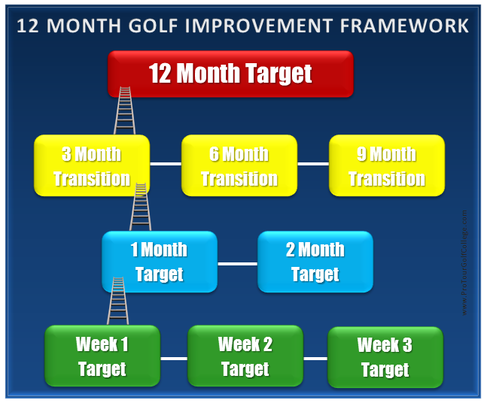5 Golf Improvement Hacks: How to Get Your Game Unstuck and Back On-Track Fast with Hack # 316/8/2014
 If you stand on the top of a ladder you can get a better view of where you are, which makes it easier to work out where you wish to go. You start at the bottom of the ladder and place one foot on a step, and then another, and you push yourself up through each step until you reach the top. These steps are transition points on the journey to the top of the ladder. They are in a lot of ways like rest and reflection stops along the way that help you to know that you are making progress. How much easier do you think it would be to get your game through a tough patch if you knew that the key to moving through-over or around your current performance obstacle got down to making the next step on the ladder? That’s right, many times the obstacle holding you and your game back can be removed by simply making the next step--with one small but important requirement; that next step you decide on is part of a well imagined and well defined process to a much better golf reality within a 12 month period. The trouble with this idea is of course that you have to know where you want your game to go, and there lies the challenge for many golfers, they often don't know where to go with their game, hence the problem of being stuck. And when all is said and done; where there’s no process for improvement, there’s also no goal. Too often golfers who get stuck with their game are continually reacting to poor performances in the moment. They will quite often resort to trying this method or that tip to try to get themselves around the problem, rather than looking at the bigger picture first, of where they want their game to be further down the road. With a big picture view of your game it is easier to decide on the steps that would lead you through the sticking point to the other side. This doesn’t mean that the place you decide on is your ultimate destination, because achieving goals is not so much about getting to destinations as it is about passing through transition points. Transition points are the guide posts along the way to your bigger goals, and they help you to know whether you are on track or off track with your game. You are putting effort into your game so you can make progress, and the guide posts provide feedback that you are getting there. And that's what this weeks golf improvement hack is all about.  Golf Improvement Hack # 3: Build Transition Points to Create Momentum Our golf improvement hack this week will show you how to create a simple yet highly effective way to set guide posts along your development pathway to help you build the necessary momentum to drive your game forwards. So assuming that your game is stuck in a bit of a rut at the moment, a good starting point might be to decide where you want your game to be in 12 months’ time? Have you ever thought about where your game will be 12 months from now? Start imagining a better version of you and your game. What would that look like? If you are someone who has been struggling to break through to a better game this might be challenging, but believe me it is important that you start imagining where you want your game to go. When we ask this question to our students at Pro Tour Golf College; “where do you want your game to be in 12 months,” we mean that we want them to define what level of success they would like to achieve within that time period. This could be an improved score average; or a particular change to a part of their technique; or possibly a tournament result. The 12 month view is always a good starting question to help you to clear your thoughts and helps you to get your game unstuck, so you can start making progress. The clearer you are about a 12 month goal the better; then you can build the transition points along the way that lead you and your game through 12 months of lessons, practice and playing tournaments. The Transition Momentum Model So have a look at our simple info graphic below describing our Transition Momentum Model that will help you to think about where you game is right now and determine what your transition points would be over a 12 month period. In this example I'm using a 12 month score average as the target, and in our illustration our golfer has a 78.6 competitive stroke average and she has decided to aim for an improvement 2.6 strokes within 12 months. This would be a very reasonable target to aim for. Now the idea from here is to chunk down the 12 month number (which in this case is 76) into smaller and more manageable bites, and then go to work on the first one only. For example, you can see that the first chunk at the 3 month transition is just .65 of a stroke better than 78.6. I'm sure that you agree that .65 is not a lot of improvement, but keep in mind it is improvement, therefore doing what you have done up until this point of time won't give you .65 of a stroke improvement in the first 12 weeks unless you change what you are doing. How do you do this? Once you have worked out your transitions, the key is to determine what you need to do in the first month with the help of your golf instructor to get to the first transition point. Once you have worked out what you want to achieve in the first month, then chunk it down further and further to where you are working out what you will do in the first week. Get the idea? How did we arrive at this number of .65 of a shot you might be asking yourself? We started with a realistic target score for 12 months of 76.0 and we subtracted it from our current score average of 78.6, and then divided it by 12 (78.6 minus 76 divided by 12 equals .65). We then subtract .65 from each transition target (3, 6 and 9 months) and then you work out what type of golf lessons you will need between each 3 month transition, plus the type of practice strategies that will help you achieve your 3 month score. You play in tournaments and your strategy is to implement what you have been working on with your instructor to achieve ---or get as close to these interim targets as possible. These transitions help you to create momentum in your game which in this context means that the transitions provide you with the fuel or impetus for your journey forwards. The Power of Momentum Momentum is a very cool principle that describes the energy gained by a moving object. Momentum in your game is derived from the energy of your positive thoughts focused around short-term goals (your transition points) which when translated into your weekly effort develops weak skills into strong skills and creates confidence. This confidence builds your momentum and keeps you moving continually along your golf improvement pathway. Momentum also describes how hard it is for your progress to slow down and stall. If you have formulated really useful physical/mental weekly, monthly and quarterly development strategies, you build the momentum you need. Remember transition points are like fuel stops along the way that feed the momentum and keep you heading towards your goals. You need these transition points to stay the course, and if your 12 month goal is truly worthy of your effort, then the transition points will just help you more than you can imagine.  So start to build weekly and monthly development targets around your quarterly transition points for improving your score average, or for improving your golf swing, or some part of a technique you want to improve. We guarantee that you will not only get yourself out of the rut you're in, but you will build huge momentum and take your game anywhere you want it to go. See you next week for Golf Improvement Hack # 4. Lawrie Montague and David Milne - Pro Tour Golf College Your Success On Tour is Our Business Comments are closed.
|
Archives
June 2019
|
Proudly Supported By
Copyright © 2011 - 2018 Pro Tour Golf College
Website Managed By Golf Performance Media
All Rights Reserved
Website Managed By Golf Performance Media
All Rights Reserved





 RSS Feed
RSS Feed



